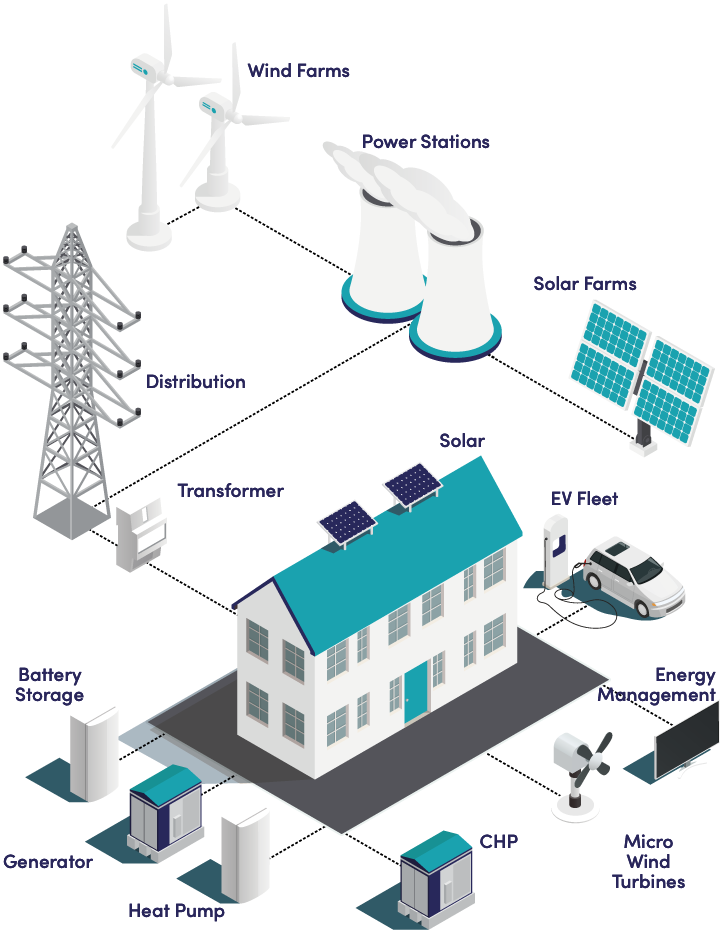On-Site Generation
On-Site Generation comprises a variety of technologies with different operating characteristics, including: 1) Energy Generation Types, (electricity, heat, cooling), 2) Generation Efficiency, 3) Carbon Footprint, 4) Fuels used and 5) Cost to Produce and Support.
Selecting the appropriate technology or technologies will determine how your organisation moves towards a lower carbon or Net Zero footprint, with what savings and at what cost.

Wind Farms
Low carbon renewables account for approximately 36% (Source: ONS, National Grid) of UK electricity with Wind contributing 26.8% in 2022. Plans are already in action to increase offshore wind’s output from 11GW to 50GW by 2030.
The 'greening' of the grid continues with over 176GW of projects waiting to be connected to add to the current capacity of 64GW already connected. Forecasts are that this will take over a decade to connect.
Power Stations
Natural gas power stations still account for approximately 40% of the energy generated by the grid. (Source: ONS, National Grid). These numbers vary depending on the contribution made by Renewables, Nuclear, Coal and Imports.
Solar Farms
Solar technology efficiency and generation output continue to improve coupled with its environmental value as a renewable.
Solar Farms numbered circa 500 in 2022 and contributed 4.4% to the national Grid. Solar capacity is forecast to grow five-fold from 14GW to roughly 70GW by 2030. (Source: ONS, National Grid)
Distribution
The UK's Transmission and Distribution network reduces the efficiency of electricity delivered by the grid. It also adds to the carbon footprint for all energy generated including renewables.Transformer
For many sites the capacity of substations and transformers to deliver additional electricity is limited. This can result in costly upgrades borne by the end customer.Heat Pump
The benefits of heat pumps needs to be calculated across varying seasonality factors including average outside temperatures and electricity usage to power its operation
Solar
Solar PV installed alongside baseload generation including CHP & Generators will ensure that a good proportion of the electricity generated will be zero or low carbon
Battery Storage
Battery Storage takes advantage of both excess electricity generated on site or cheaper night rate electricity. This is then stored and used to fill peak demand when needed.EV Fleet
Businesses are increasingly installing EV Chargers to provide charging to customers and for delivery and support fleets. Depending on size of charger installed this can add significantly to the site electricity demand.Energy Management
Energy Management Systems including BMS (Building Management Systems) ensure that an integrated approach to multiple technologies can be achieved. The need to match energy demand with generation coupled with smart charging systems to minimise costly grid energy is key to reducing overall costs.
Micro Wind Turbines
Micro-wind turbines are an efficient renewable technology, but planning policy and public acceptance needs to evolve before widespread usage increases.Generator
Generators provide the baseload site generation and are ideally integrated with other low carbon and renewable technologies to provide for energy peaks and troughs.
Unlike CHPs, generators do not typically deliver additional heat but are still efficient generators of electricity compared with the grid.
CHP
Combined Heat and Power (CHP) technologies provide the baseload site generation and are ideally integrated with other low carbon and renewable technologies to provide for energy peaks and troughs.
The efficiencies of generating two energy types, heat and power, from a single fuel makes them one of the most efficient and cost-effective technologies available.
The UK Energy Dilemma
The UK energy market faces continuing pressure to produce and deliver energy to public and private businesses.
Energy prices have risen at considerably more than inflation for the last 25 years and that trend shows no sign of slowing down.
While the energy generated by renewables connected to the grid continues to increase, circa 40% is still generated by inefficient gas power stations. The cost of electricity for the consumer is partly down to the cost of wholesale energy, but also down to the process of generation and distribution, where there is up to 80% loss before delivery to the end user.
An increasing percentage of a business’s infrastructure costs are taken up by energy, with these costs diverting precious capital away from investments that can contribute to ‘front line’ services.
Faced with this position CEOs, CFOs, Facility Managers
and Energy Managers are seeking innovative financial
and technology solutions that also reduce the carbon footprint of the energy used on-site.
OS Gen’s portfolio of technologies and its Capital funding approach address both the inefficiencies of energy supplied by the grid, carbon footprint reduction and the need for valuable capital to be allocated away from front line services.
Reduce your carbon footprint & save money on your business energy today.
Contact OS Gen today
Save money, carbon footprint and efficiency on your business energy today.
